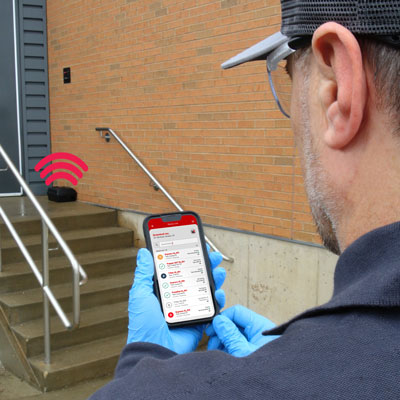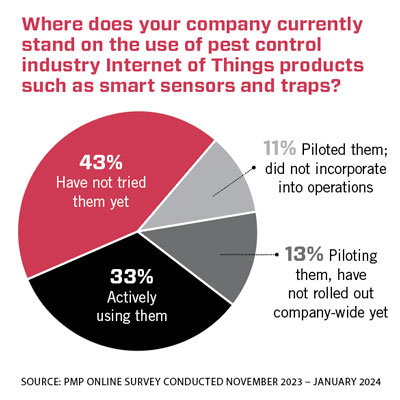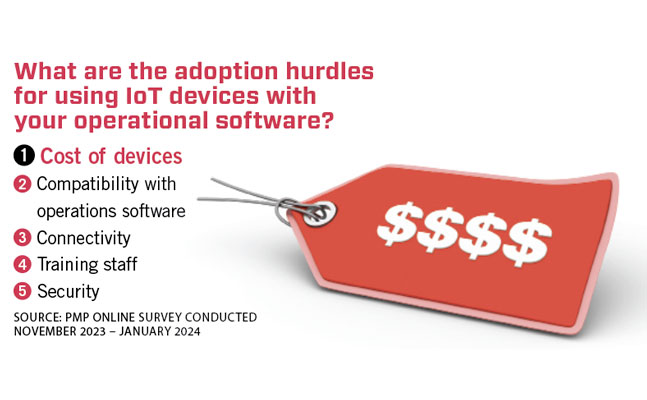
IoT technology helps pest control technicians focus on the hot spots of an account. PHOTO: BELL LABS
For decades, many pest management professionals (PMPs) have been keeping structures sound and customers safe by eliminating pest infestations without the aid of internet-powered remote technology. A bright flashlight, a strong magnifying glass and a reputable resource manual of pest species were among the most important tools in most PMPs’ toolboxes. Over the past 30 years, however, technological advances in the pest control industry have allowed PMPs to embrace change.
As we venture into 2024 and explore new technologies, one of the biggest concepts being talked about is internet of things (IoT). The U.S. Department of Commerce’s National Institute of Standards and Technology defines IoT as devices — including, but not limited to sensors, controllers and household appliances — with a connection to the internet. In addition, the institute describes IoT as “the network of devices that contain the hardware, software, firmware and actuators [that] allow the devices to connect, interact and freely exchange data and information.”
In the pest control industry, that currently includes, but is not limited to:
- GPS trackers that monitor and record time, location, direction and speed. The data is then used to generate reports in route optimization software. Companies armed with this knowledge can plan routes more efficiently to conserve fuel and save time.
- Office automation solutions that manage services and billing. While technicians are out in the field, they can send service notes, invoices and payments to the office.
- Smart pest traps that are equipped with sensors and cameras, and notify PMPs when rodent or other pest activity occurs. PMPs can use the data collected to generate reports and plan more effective control strategies.

Dr. Hamilton Allen, BCE
Increasing use
Even PMPs who don’t plan to use IoT pest management products often encounter it in the field, because many customers already use this technology in their homes. Homeowners’ smart TVs enable them to stream shows and music. Their smartphones let them control their thermostats and lights, and view activity caught on security and doorbell cameras.
“Although security cameras and doorbell cameras aren’t provided by pest management organizations, these devices are having a huge impact on service accountability,” says Dr. Hamilton Allen, BCE, VP of Technical and Safety for Fox Pest Control, Logan, Utah, and a member of Pest Management Professional’s (PMP’s) Editorial Advisory Board (EAB). “We must begin training our team members on how to interact with remote customers and let them know someone is always watching.”
Hawx Services does just that. Scott Broaddus, VP of Expansion for the Ogden, Utah-based pest control company, says during training, customers’ use of cameras is stressed.

Scott Broaddus
“We make it really apparent, because 75 percent to 80 percent of our residential customers aren’t home when we provide service,” adds Broaddus, who earlier in his career was the sales and business lead for Bayer Digital Pest Management, a legacy company of Envu. Last month, Envu sold its IoT-enabled Rodent Management System to Woodstream. “When we measure the customer experience through a Net Promoter Score [or NPS], customers will acknowledge they saw their technician do something — good, bad, indifferent — on their home cameras. So, we make our technicians aware that somebody’s always watching.”
Look around, and you’ll see such technology is being used just about everywhere.
“Technology has touched all aspects of life and business,” confirms Massey Services’ VP of Technical & Training, Tom Jarzynka. Technicians at the Orlando, Fla.-based company rely on several IoT products, from rodent traps to cameras. “Electronic monitoring, data management and other technological advances will be a significant part of pest management in the future,” he adds.

Tom Jarzynka
Reliable solutions
Rentokil Terminix has long championed the use of leading-edge technology in pest control. Its technicians have been using PestConnect — a system of connected devices that detect, capture and/or eliminate rodents — for more than a decade. Its first connected solution, RADAR (Rodent Activated Detection and Riddance) launched nearly 20 years ago.
“Our trusted solutions continuously monitor customer premises and, together with rapid response from our expert technicians, are proven to provide businesses with enhanced protection against costly infestations in a more sustainable way,” explains Constantin Schwarz, the company’s residential connect product owner. “Our customers have really welcomed the peace of mind that PestConnect can offer, with round-the-clock monitoring and protection enabling quicker intervention and heightened security against pests.”
Those interviewed for this story agree that when the concept of IoT was first introduced in the pest control industry, the focus was primarily on the products themselves. Schwarz says today’s PMPs have come to realize the real-time data these products generate is indispensable.
“We’ve unlocked the power of this data to reveal detailed pest activity trends at customer sites, and use it as evidence of the value of connected pest control for customers,” he adds. “That’s what’s special for customers: ‘We knew about your pest activity sooner, we intervened sooner, but just as important, we got you pest-free again sooner.’”
As helpful as it is, however, pest control companies cannot rely on technology alone. “It’s the combination of the technology and the expertise of our people that all come together to give us something that’s valuable and important to our customers,” Schwarz says.

Illustration: Avector / iStock / Getty Images Plus / Getty Images
Evolving options
Technology is constantly evolving, and that’s good news for PMPs who have embraced the options currently available, as well as PMPs who hesitate to give them a try.

Doug Foster
“IoT has come a long way in disrupting and improving the pest control industry, and I look for it to continue at an even quicker pace,” says Doug Foster, president of Burt’s Termite & Pest Control in Columbus, Ind., and a PMP EAB member. “Remote monitoring and reporting are getting better; routing software is making us more efficient; and the opportunities are drawing bigger ‘technology players’ into our industry. I’m very optimistic about the future of IoT in making us better.”
To learn more, PMP conducted an online survey to find out where PMPs stand on the use of IoT in the pest control industry. As it turns out, 33 percent of responding PMPs are actively leveraging IoT-enabled technology.
Although 43 percent say they have not tried IoT tools, many, like Buddy Herring, owner of Summit Pest Solutions in Fletcher, N.C., are open to the idea. Our survey shows cost is the top reason PMPs cite for not implementing IoT-enabled products at their companies.
“Will the cost actually offset labor for a smaller company like ours?” Herring asks. “I’m all for automation when it makes sense, especially with the staffing challenges we face. I do not think anything will ever truly replace good old-fashioned boots-on-the-ground service work, though.”
Multiple benefits

Pete Schopen
Technology may be key to attracting and retaining technicians, however.
“Smart sensors and monitors make a ton of sense in our industry,” says Pete Schopen, founder of RV There Yet Consulting, McHenry, Ill., and a PMP columnist and EAB member. “They clearly make the technician’s job much simpler. After all, who wants to bend over 100 times, checking bait stations at an apartment complex?”
Anyone who has watched a technician attempt to service 250 bait stations or snap traps in a half-million square foot warehouse, as Hawx’s Broaddus has, knows it is not a glorious job.
“A lot of people overlook the impact that bringing in technology can have on an employee,” he says. “What better way to make that job more attractive, and recruit people from other industries?”
Perhaps one day, the task will evolve, Broaddus points out. Instead of hiring a technician to check hundreds of traps, and hoping he or she will stick around, companies may one day seek out an employee with a data science background or an interest in predictive analytics who can analyze data generated from IoT-enabled traps and devise a solution to quickly gain control of an infestation.
Schwarz advises PMPs to consider connected pest control as another tool in their toolboxes. “It provides an early warning system to pest activity, which gives our frontline teams the head start they need to resolve pest issues more quickly,” he says. “As Rentokil Terminix experts continue to gain knowledge about operating and managing large-scale PestConnect deployments, for example, they are also helping to innovate further in terms of remote monitoring and alerting, as well as more interactive reporting. All of this helps us become more proactive in helping customers stay pest-free.”
Broaddus agrees that customers reap the benefits when pest control companies embrace technology. “For Hawx, technology is not necessarily about remote monitoring, it’s about finding ways to lean into technology to enhance the customer experience,” he says. “It’s more about how we digitize our service tickets, get better at routing, and create apps to provide good sales experiences for not only our employees, but our customers as well.”

Illustration: porcorex / E+ / Getty Images
Breaking barriers
Broaddus maintains that PMPs need to adapt to the ways in which technology will help them become more efficient and successful. “The biggest barrier is PMPs not investing the time and energy to reshape their service and business models,” he says. “They can free up their labor and create much more value for their customers.”
PMPs need to let the technology handle the monitoring, and in turn, they will be able to service more customers. “They can hone in on what a lot of customers really want, which is identifying and addressing issues, and not doing mundane work like checking traps,” Broaddus adds.
In the end, customer service remains critical to the success of a pest control company, no matter how many IoT-enabled products its technicians use.
“We believe technology alone is never the answer. Our people will always remain at the heart of our service,” Schwarz confirms. “People plus technology is always better than technology alone.”
Leave A Comment